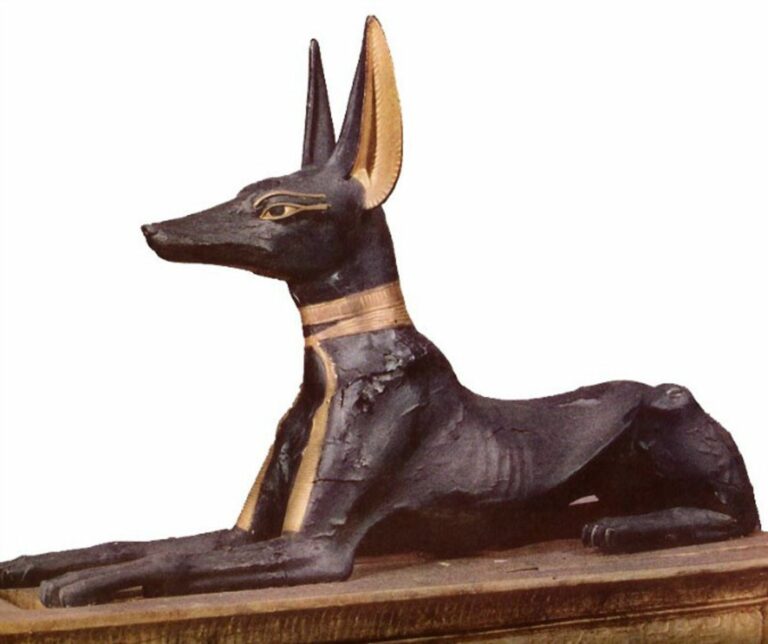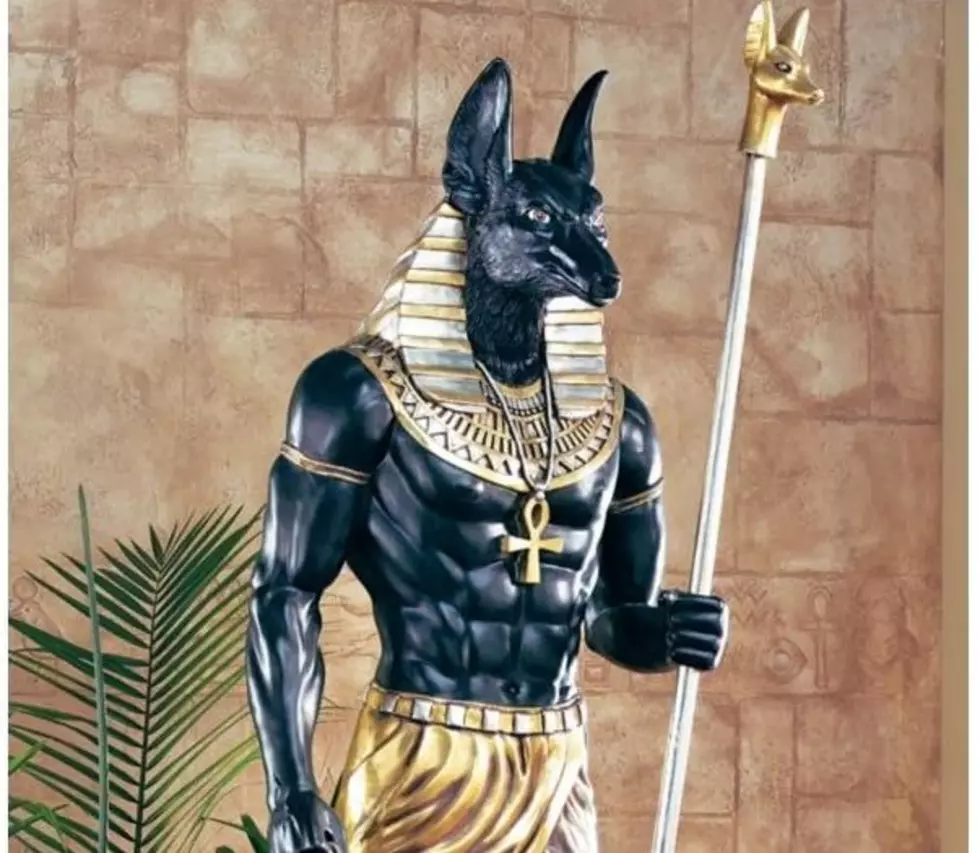Meaning
The Jackal God
Anubis is a prominent deity in ancient Egyptian religion, primarily associated with death, mummification, and the afterlife.
The name Anubis derives from the ancient Egyptian word “Inpw,” which means “he who is over there” or “guardian of the underworld.” His distinctive jackal head, often depicted in artistic representations, symbolizes his role as a protector of the deceased and guide through the intricate journey to the afterlife.
Anubis’s origins are shrouded in antiquity. His cult predates the unification of Upper and Lower Egypt, suggesting a deep-rooted connection to funerary practices in prehistoric times. As one of the oldest deities in Egyptian mythology, he embodies the primal fear and fascination with death that pervades human existence.
The ancient Egyptians believed that Anubis played a crucial role in preparing the dead for their journey into the afterlife. He oversaw the mummification process, meticulously wrapping the deceased’s body in linen bandages and applying resins to preserve it from decomposition.
In the Egyptian underworld, Anubis presided over the Weighing of the Heart ceremony, where a person’s heart was weighed against the feather of Maat (truth and justice). If the heart was deemed pure and balanced, the deceased would be allowed to enter the celestial paradise known as the Field of Reeds. If not, they faced the wrath of Ammit, a monstrous creature who devoured the hearts of those found unworthy.
Anubis’s multifaceted nature encompassed both terrifying and comforting aspects. While his association with death could evoke fear, he also offered solace to those grieving their loved ones. He was seen as a protector of the dead, guiding them safely through the perilous underworld and ensuring their passage into the afterlife.
Guardian of the Dead
Anubis, with his distinctive jackal-headed visage, holds a prominent position in Egyptian mythology as the god of mummification, the afterlife, and funerary rites. His name, believed to originate from the ancient Egyptian word “Inpu,” translates roughly to “The One Who is at the Mouth” or possibly “Lord of the Dead.” This evocative name reflects his central role in guiding souls through the treacherous journey to the underworld.
Anubis’s association with jackals stems from their scavenging nature and presence near graveyards, a natural link to death and decomposition. However, Egyptians also observed that jackals were faithful creatures, often returning to their dens even after days of wandering. This duality – the acceptance of death alongside loyalty – contributed to Anubis becoming a revered protector of the deceased.
His role in mummification was crucial. Ancient Egyptians meticulously preserved bodies through elaborate rituals, believing it essential for a successful afterlife. Anubis oversaw this process, ensuring that each step was performed correctly and that the deceased’s spirit could transition smoothly into the next realm.
During the Weighing of the Heart ceremony, Anubis played a pivotal role. He weighed the heart of the deceased against a feather symbolizing Ma’at (truth and justice). If the heart was lighter than the feather, signifying a life lived in balance and righteousness, the deceased could pass into paradise. However, if it was heavier, indicating sins and transgressions, Anubis guided the soul towards eternal damnation.
Anubis’s influence extended beyond earthly matters. He was depicted as a guide and protector for souls traversing the underworld. His knowledge of the afterlife paths and rituals ensured safe passage and protection from malevolent spirits.
Throughout Egyptian history, Anubis’s importance remained constant. His image adorned tomb walls, sarcophagi, and amulets, serving as a talisman to ward off evil and ensure a successful journey into the afterlife. His enduring legacy speaks to his profound influence on ancient Egyptian beliefs about death, the soul, and the journey beyond.
Origin
Ancient Egyptian Mythology
Anubis, a prominent figure in ancient Egyptian mythology, stands as the god of mummification and the afterlife. His distinctive jackal head, representing death and decomposition, has become synonymous with funerary practices in Egypt.
The origin of Anubis’ name is shrouded in antiquity, with several theories proposed by scholars. One theory suggests that “Anubis” derives from the ancient Egyptian word “Inpu,” which likely means “the one who decays” or “he who is at the edge.”
This interpretation aligns with his association with death and the decomposition of bodies during mummification.
Another theory proposes that Anubis’ name stems from the combination of two words, “Anu,” representing the sky god, and “Pius,” signifying protector.
This connection highlights his role as a guardian deity overseeing the transition to the afterlife.
The historical development of Anubis is marked by significant changes in his portrayal and significance over time:
- Early Dynastic Period (c. 3100-2686 BCE): Anubis appears as a local deity primarily associated with the necropolis of Cynopolis, identified by ancient Greeks as the “city of dogs.”
- Old Kingdom (c. 2686-2181 BCE): Anubis gradually gains prominence as a national deity, particularly in connection with mummification rituals and funerary rites.
- Middle Kingdom (c. 2055-1650 BCE): Anubis’ role expands to encompass the weighing of the heart ceremony, where his judgment determined the soul’s fate in the afterlife.
- New Kingdom (c. 1550-1069 BCE): Anubis reaches the zenith of his popularity, depicted alongside Osiris and Isis in funerary texts and imagery.
- Late Period (c. 664-332 BCE):Anubis’ influence wanes as other deities like Serapis gain prominence.
Throughout history, Anubis has endured as a powerful symbol of death and the afterlife in ancient Egypt, leaving an indelible mark on funerary practices and religious beliefs.
History
Depictions in Art and Literature
Anubis, a prominent figure in ancient Egyptian mythology, is best known as the jackal-headed god associated with mummification, the afterlife, and funerary rites. His name, derived from the ancient Egyptian word “Inpu,” likely meaning “the one who is at the door” or “he of the golden bark,” reflects his role as a guardian of the underworld and a guide for souls in their journey to the afterlife.
Anubis’s origins can be traced back to Predynastic Egypt, predating the unification of the kingdom. He was initially depicted as a jackal, a sacred animal symbolizing protection and guardianship. Over time, Anubis evolved into a more anthropomorphic form, with a jackal head atop a human body.
Ancient Egyptians believed that Anubis assisted in embalming the deceased and guiding their souls through the underworld. He played a crucial role in the weighing of the heart ceremony, where the deceased’s heart was placed on a scale against the feather of truth. If the heart weighed heavier than the feather, it signified sin, and the soul would be devoured by Ammit, a monstrous creature.
Anubis is often depicted with his iconic jackal head adorned with a black nemes headdress. He carries a variety of tools associated with mummification, such as the ankh (symbol of life), the was scepter (representing royalty and power), and the djed pillar (symbolizing stability and strength).
Throughout history, Anubis has been portrayed in various forms in art and literature. Ancient Egyptian tomb paintings depict him presiding over mummification rituals. In the Book of the Dead, a collection of funerary spells, Anubis guides the deceased through the underworld and protects their journey.
Beyond ancient Egypt, Anubis has resonated throughout Western culture. He appears in classical literature, mythology, and popular culture. His image has been used as a symbol of death, mystery, and transformation, often depicted with his jackal head and tools associated with mummification.
Evolution of Anubis’ Role
Anubis, a prominent figure in ancient Egyptian mythology, has undergone an intriguing evolution in his representation and significance within English language discourse.
The name “Anubis” itself is derived from the ancient Egyptian word inpu, meaning “the one who is over there” or “the one who is at the end.” This etymology hints at Anubis’ initial role as a deity associated with death, decay, and the underworld.
In early Egyptian texts and artwork, Anubis was depicted primarily as a jackal-headed deity, symbolizing his connection to scavenging animals and the natural process of decomposition.
His function was largely focused on guiding souls through the perilous journey into the afterlife. He would mummify corpses and weigh hearts against the feather of Maat, ensuring proper judgment by Osiris.
Over time, Anubis’ association with death became more nuanced. While still a guardian of the dead, he also evolved into a protector and guide for the deceased, facilitating their safe passage into the underworld.
This shift in perception can be seen in later depictions of Anubis, where he is portrayed with a gentler demeanor, often assisting Osiris in judging souls.
The introduction of Egyptian mythology to the Western world through classical texts and exploration fueled the spread of Anubis’ name and image.
During the Greco-Roman period, Anubis was assimilated into the broader pantheon, sometimes identified with Hermes or other messenger deities due to his role in guiding souls.
The word “Anubis” itself entered English through Latin and Greek influences. It gradually became a common name for anything related to death, mummification, or ancient Egypt.
Today, Anubis remains a recognizable and iconic figure, often used in popular culture to represent themes of death, the afterlife, and Egyptian mythology.
- Meaning, Origin And History Of The Name Ginka - April 27, 2025
- Best Leadzai Alternatives for 2025 - April 25, 2025
- Best GetProspect Alternatives for 2025 - April 25, 2025


